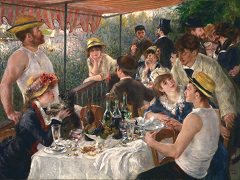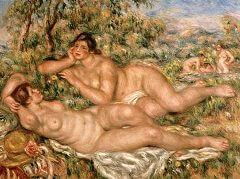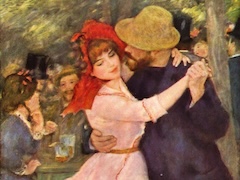The Stairway, Algiers - by Pierre-Auguste Renoir

This painting, The Stairway, Algiers of torrid sunlight and dense foliage shows us much about Renoir's way of approaching a subject. Albert Andre writes: "He attacks his canvas, when the subject is simple, by putting in with the brush, usually in brownish-red, some general outlines in order to see the proportions of the elements which will compose his picture...then, immediately, with pure colors diluted by turpentine, as if he were painting with watercolor, he strokes the canvas rapidly and soon you see something vague appear, with iridescent colors, the tones flowing into one another; something that charms you even before you grasp the sense of the image."
The figures in the extreme right foreground are lightly indicated by a few strokes of the brownish-red that establishes the general scheme of the picture. With this shorthand note as a clue, one becomes aware that a major element of the compositional organization occurs in the degree of finish of the various parts of the canvas. In the figures and steps of the foreground there is a sketchy, freehand quality much like the technique of watercolor. The loosest technique is in the most open areas; farther up, the brushwork of the wall and the trees becomes closer, the pigment thicker, and the foliage richer in detail. The separated color areas of the foreground are developed with a great range of hues at the top of the canvas.
Renoir delights in the contrast of the sunlight, which bleaches color where it hits the scene directly, and the glow of the shadow areas. Shadow here is not darkness - the absence of light - but another kind of light and color; it is hard to imagine a more wonderful, varied play of related colors than the iridescent light and warm lavenders of the wall and facade at the top. Something of each of the different elements - the small brush notes of the foliage, the architecture, and the softly painted sky - is fused in the treatment of the buildings. The human figures are merely sketched in; yet Renoir's sure instinct for essentials gives them convincing reality.















